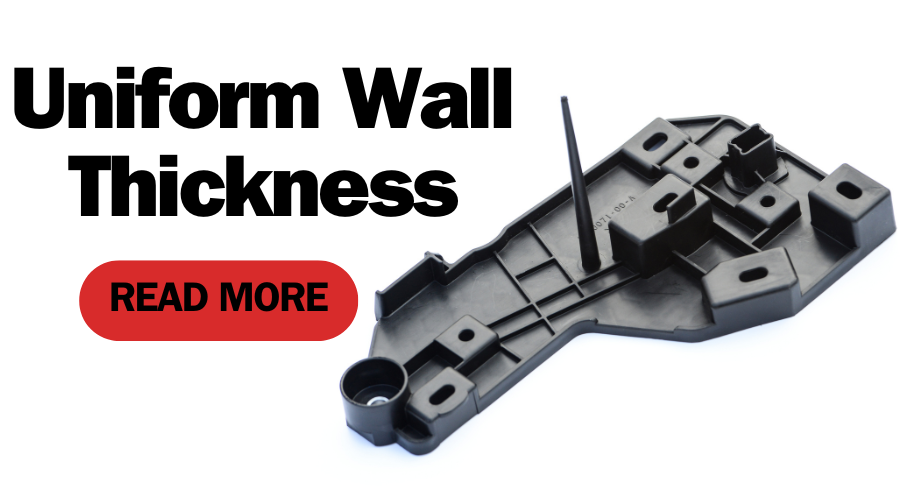In the world of manufacturing, precision is paramount. Every detail, no matter how seemingly minor, can make a significant difference in the quality and functionality of the final product. This is particularly true in injection molding, a widely used manufacturing process that produces intricate parts with remarkable efficiency. Among the many factors that contribute to successful injection molding, one of the most crucial yet often overlooked aspects is uniform wall thickness.

What exactly is uniform wall thickness, and why does it matter? Simply put, it refers to maintaining consistent thickness throughout the walls of a molded part. While it may seem like a minor detail, it can have a profound impact on the structural integrity, performance, and aesthetics of the finished product. Let’s delve deeper into why uniform wall thickness is so important in injection molding.
- Prevents Warping and Distortion: Inconsistent wall thickness can lead to uneven cooling rates during the molding process. Areas with thicker walls will cool more slowly than thinner sections, resulting in internal stresses that can cause warping, distortion, or even cracking in the final product. By ensuring uniform wall thickness, these issues can be minimized, leading to parts that are dimensionally stable and free from defects.
- Enhances Strength and Durability: Parts with uniform wall thickness exhibit greater strength and durability compared to those with varying thickness. Irregularities in wall thickness create weak points that are more prone to failure under stress or load. By maintaining consistency, the structural integrity of the part is reinforced, making it better suited for its intended application.
- Improves Flow and Filling: Uniform wall thickness facilitates smoother flow of molten material during the injection molding process. When the thickness varies, it can result in uneven filling of the mold cavity, leading to incomplete parts, voids, or other defects. Consistent wall thickness promotes optimal material flow, ensuring that the entire mold cavity is properly filled and packed, thus reducing the risk of defects and improving overall part quality.
- Reduces Material and Production Costs: Another significant advantage of uniform wall thickness is its efficiency in terms of material usage and production costs. Parts with consistent thickness require less material to manufacture, leading to reduced material waste and lower production costs. Moreover, uniformity simplifies the molding process, reducing the need for adjustments and minimizing cycle times, ultimately increasing productivity and profitability.
- Enhances Aesthetic Appeal: Beyond functionality, uniform wall thickness contributes to the aesthetic appeal of the final product. Smooth, even surfaces without noticeable variations in thickness enhance the visual appearance of the part, giving it a polished and professional look. Whether it’s a consumer product, automotive component, or medical device, aesthetics play a crucial role in consumer perception and brand reputation.
Achieving uniform wall thickness in injection molding requires careful design considerations and meticulous attention to detail. Design engineers must carefully analyze the geometry of the part, ensuring that wall thickness remains consistent across all sections. This may involve optimizing part geometry, incorporating features such as ribs or bosses for reinforcement, and strategically placing gate locations to facilitate uniform material flow.
Furthermore,collaboration between design engineers and mold makes is essential to address any challenges related to tooling design and mold cavity geometry. Advanced simulation tools can also be employed to analyze mold filling patterns, predict potential defects, and optimize process parameters to achieve the desired outcome.
In conclusion, uniform wall thickness is not merely a cosmetic consideration but a fundamental aspect of successful injection molding. By prioritizing consistency in wall thickness, manufacturers can produce high-quality parts that meet stringent performance requirements while minimizing defects and production costs. In a competitive market driven by innovation and efficiency, attention to detail can make all the difference in delivering superior products that exceed customer expectations.
How to Design for Uniform Wall Thickness
Design for uniform wall thickness is crucial for ensuring the success of injection molding processes. Here are some key strategies to achieve uniform wall thickness in your designs:
1. Maintain Consistency: when designing parts for injection molding, aim to keep wall thickness as consistent as possible throughout the entire geometry. This means avoiding abrupt changes in thickness, leading to uneven cooling and potential defects.
2. Using Ribbing and Gussets: Incorporating ribs and gussets into the design can help reinforce areas of the part without adding unnecessary thickness. These features distributes stress more evenly, reducing the risk of warping or distortion while maintaining overall uniformity in wall thickness.
3. Avoid Sharp Corners: Sharp corners can create stress concentrations and flow restrictions during molding. Instead, use fillets or radii to smooth out corners, promoting better material flow and reducing the likelihood of defects.
4. Design with Draft Angles: Including draft angles in your design facilitates easier ejection of the part from the mold and reduces the likelihood of surface defects. This can help maintain uniform wall thickness by ensuring consistent material flow throughout the mold cavity.
5. Optimize Gate Placement: Strategically placing gates in areas of the part where material flow is less critical can help minimize the impact on wall thickness. By carefully selecting gate locations, you can promote more uniform filling of the mold cavity and reduce the risk of variations in wall thickness.
6. Consider Material Properties: Different materials have varying flow characteristics during injection molding. When designing parts, take into account the material properties and how they may affect flow behavior and cooling rates. Adjust the design accordingly to ensure uniform wall thickness is maintained.
7. Utilize Simulation Software: Advanced simulation software can be invaluable for analyzing and optimizing part designs for injection molding. These tools can simulate the flow of molten material, predict potential defects, and optimize process parameters to achieve uniform wall thickness and high-quality parts.
By incorporating these strategies into your design process, you can effectively achieve uniform wall thickness in injection-molded parts, resulting in higher quality, more consistent products. This not only improves the performance and durability of the parts but also enhances the overall efficiency and cost-effectiveness of the manufacturing process.
-q4gvl4k29y4hq8j9rjpapvj0ft06fje63olt7p210i.png)


